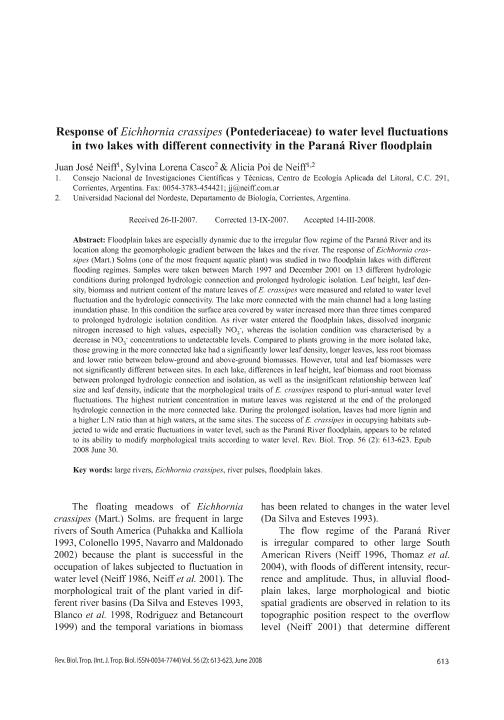Artículo
Response of Eichhornia crassipes (Pontederiaceae) to water level fluctuations in two lakes with different connectivity in the Paraná River floodplain
Fecha de publicación:
02/2007
Editorial:
Universidad de Costa Rica
Revista:
Revista de Biología Tropical
ISSN:
0034-7744
e-ISSN:
2215-2075
Idioma:
Inglés
Tipo de recurso:
Artículo publicado
Clasificación temática:
Resumen
Floodplain lakes are especially dynamic due to the irregular flow regime of the Paraná River and its location along the geomorphologic gradient between the lakes and the river. The response of Eichhornia crassipes (Mart.) Solms (one of the most frequent aquatic plant) was studied in two floodplain lakes with different flooding regimes. Samples were taken between March 1997 and December 2001 on 13 different hydrologic conditions during prolonged hydrologic connection and prolonged hydrologic isolation. Leaf height, leaf density, biomass and nutrient content of the mature leaves of E. crassipes were measured and related to water level fluctuation and the hydrologic connectivity. The lake more connected with the main channel had a long lasting inundation phase. In this condition the surface area covered by water increased more than three times compared to prolonged hydrologic isolation condition. As river water entered the floodplain lakes, dissolved inorganic nitrogen increased to high values, especially NO3-whereas the isolation condition was characterised by a decrease in NO3- concentrations to undetectable levels. Compared to plants growing in the more isolated lake, those growing in the more connected lake had a significantly lower leaf density, longer leaves, less root biomass and lower ratio between below-ground and above-ground biomasses. However, total and leaf biomasses were not significantly different between sites. In each lake, differences in leaf height, leaf biomass and root biomass between prolonged hydrologic connection and isolation, as well as the insignificant relationship between leaf size and leaf density, indicate that the morphological traits of E. crassipes respond to pluri-annual water level fluctuations. The highest nutrient concentration in mature leaves was registered at the end of the prolonged hydrologic connection in the more connected lake. During the prolonged isolation, leaves had more lignin and a higher L:N ratio than at high waters, at the same sites. The success of E. crassipes in occupying habitats subjected to wide and erratic fluctuations in water level, such as the Paraná River floodplain, appears to be related to its ability to modify morphological traits according to water level.
Palabras clave:
Large Rivers
,
Eichhornia Crassipes
,
River Pulses
,
Floodplain Lakes
Archivos asociados
Licencia
Identificadores
Colecciones
Articulos(CECOAL)
Articulos de CENTRO DE ECOLOGIA APLICADA DEL LITORAL (I)
Articulos de CENTRO DE ECOLOGIA APLICADA DEL LITORAL (I)
Citación
Neiff, Juan Jose; Casco, Sylvina Lorena; Poi, Alicia Susana G.; Response of Eichhornia crassipes (Pontederiaceae) to water level fluctuations in two lakes with different connectivity in the Paraná River floodplain; Universidad de Costa Rica; Revista de Biología Tropical; 56; 2; 2-2007; 613-623
Compartir
Altmétricas




